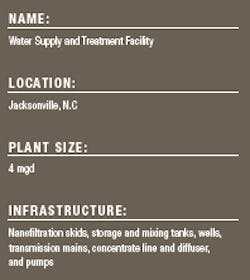About the author:
Leslie Streicher is associate editor for Water & Wastes Digest. Streicher can be reached at [email protected] or 847.954.7922.
When North Carolina officials ordered treatment plants to withdraw from an overused aquifer, the Water Supply and Treatment Facility in Jacksonville turned to nanofiltration (NF) technology to address new challenges head on.
Running Out
About nine years ago, the North Carolina Department of Environmental Resources established the Central Coastal Plain Capacity Use Area Rules, calling for 15 counties in the eastern portion of the state to withdraw from the Black Creek Aquifer. For the city of Jacksonville, Black Creek had been a primary water source for decades, supplying unusually clean water to a burgeoning community.
Prior to these regulations, Jacksonville’s water system comprised two wellfields, which extracted water from Black Creek and the auxiliary Peedee Aquifer. Because the water source is so clean, chlorination was the only necessary treatment.
“The water [at Black Creek] is very pure. You can practically bottle it right from the source,” said Jacksonville City Manager Richard Woodruff. “The problem is all the counties [in the area] were pulling out of the same aquifer.”
Alarmed by decreasing water levels, state officials ruled to withdraw all treatment plants from the creek, hoping the source will replenish itself over time.
“The state said they want to move everyone to a shallower aquifer with much more salt content—the Castle Hayne Aquifer,” Woodruff said. “So county officials started drawing up plans for new plants.”
Every few years until a 2018 deadline, plants will decrease the amount of water pumped from Black Creek by 25%, mixing the pure water with the salt-laden content of Castle Hayne.
“Although the water quality from [Castle Hayne] is generally good, it is anticipated that some parameters, such as total organic carbon, iron, hydrogen sulfide and total dissolved salts, will degrade over time,” said Plant Superintendent Raymond Holder.
Thus, treatment technology capable of adapting to varying water quality is required, and the plant chose NF technology to accommodate the brackish content.
New Challenges
Last year, the new NF treatment plant began operations. Project overhauls totaled $47.8 million, funded primarily by the North Carolina State Revolving Loan. More than 100,000 ft of piping, 16 wells and a concentrate line and diffuser comprise the most notable additions.
New wells at Castle Hayne feed into a raw water distribution system that pumps into the plant. Raw water flows through cartridge filters to remove silt and particulate matter, and antiscalant is injected to prevent fouling of the membranes.
With a 70% recovery rate, the NF system allows finished water from each stage to combine with 10% of untreated raw water from Black Creek.
“[Mixing] provides a similar odor and taste that the community is used to,” Holder said. “The blended water is acidified with 50% sulfuric acid to a pH of less than five. The [next stage] is the odor control system.”
Blended water flows to an aeration tower to reduce hydrogen sulfide and carbon dioxide content, then moves to a mixing tank where it is disinfected.
When the treatment process is complete, the finished water is stored in a 2-million-gal tank, waiting for public distribution through three low-service and three high-service pumps.
Today, the plant employs 14 professionals to supply city residents with clean water. Current capacity reaches 4 million gal per day (mgd), but growing population might spur plant expansions in the future.
“Operators love the new plant—the responsibility and knowledge needed for operation,” Holder said. “The plant can easily expand to 8 mgd with installation of new wells and membranes in existing NF skids, providing growth potential for the city over the next 20 years.”
Anticipating Growth
A year has passed since the new Jacksonville plant opened, and NF has served as a reliable bulwark against Castle Hayne’s brackish waters.
While the plant is prepared to continue operating out of the new aquifer, Woodruff said current well profiles show that Black Creek may be replenishing itself more rapidly than expected.
“We’re now of the opinion that we are causing the same thing to happen with Castle Hayne [that we caused with Black Creek],” Woodruff said. “We might go back to the state to find a new model to look at both aquifers.”
Jacksonville is poised for significant growth over the next 20 years, and it may be the most prudent solution to tap into both sources.
“It’s like having too many people in a sinking boat,” he said. “Instead of moving all of them to a new boat of the same size, move half of them to a new boat and keep half in the old. That way neither will sink.”
Download: Here
